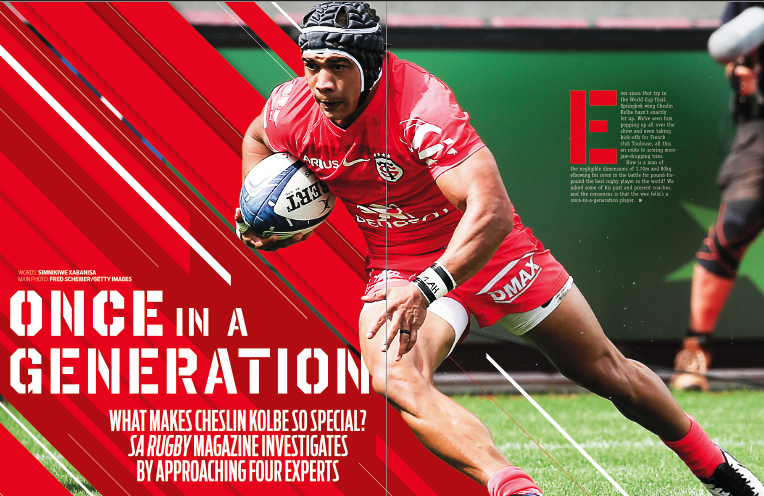What makes Cheslin Kolbe so special? SIMNIKIWE XABANISA investigates by approaching four experts in the latest SA Rugby magazine.
READ: What’s in our latest magazine?
Ever since that try in the World Cup final, Springbok wing Cheslin Kolbe hasn’t exactly let up. We’ve seen him popping up all over the show and even taking kick-offs for French Club Toulouse, all this en route to scoring more jaw-dropping tries.
How is a man of the negligible dimensions of 1.71m and 80kg elbowing for room in the battle for pound-for-pound the best rugby player in the world? We asked some of his past and present coaches, and the consensus is the wee fella’s a once-in-a-generation player.
Skill Set – Mzwandile Stick, Springbok assistant coach
Considering what Cheslin can do now between the four lines, he’s probably one of the best rugby players in the world. Most people focus on his X factor but the best thing about Cheslin is his basics.
If you look at his aerial skills, you can’t believe what he can do with his height and size. Having a sevens background, there’s nothing he can’t do: if you put him at scrumhalf he’ll deliver. Sometimes Toulouse play him at 10 and he kicks for poles. He’s a natural footballer. It’s important for a player to be solid at the fundamentals of the game because a lot of situations won’t allow for a player like Cheslin to go through like he does.
The best rugby players are those able to produce something even when there’s nothing on because they can give a good pass or secure the ball at the breakdown or carry properly. When it comes to the sevens game there’s no place to hide so a lot of his strengths evolved from that background where he’s had to deal with forwards running in his channel and apply himself physically in that battle.
When it comes to his game he’s an all-rounder, there are no weaknesses, even in his physique. Because he’s a natural footballer, school coaches wanted him closer to the ball, so they played him at flyhalf. That’s why it’s no surprise he can also play at scrumhalf, as you saw when we were in trouble with the nines against Argentina in the Rugby Championship last year.
Even with us at the World Cup, when we went for the six-two split, if we got in trouble with the numbers we knew Cheslin could deputise in whatever position because there’s nothing he can’t do, except maybe scrum …
Speed and Strength – Allan Temple-Jones, Former Blitzboks conditioning coach
Cheslin joined the sevens academy, I think in 2012, when we had a great year of Craven Week talent which included Werner Kok and Justin Geduld. He came into an extremely competitive environment where we not only put them through their paces in the academy but also exposed them to the level of training the leaders in the group were also doing.
That environment was conducive to getting the most out of players; that internal competition was instrumental to those players’ drive to succeed in terms of how far they could push themselves in training. Cheslin, Justin and even Kwagga Smith, to a certain extent, were a bit slight on the physique side but they worked extremely hard on their physical conditioning just to get stronger and fitter to tolerate those loads. When they came into the academy we gave them a good block of basic conditioning on the back of schools rugby.
That’s something Cheslin worked particularly hard on. I think the fact they were seen as small for fifteens rugby drove them to prove people wrong. They worked quite hard at it and in the sevens system we often exposed them to wrestling bigger guys like Frankie Horne. That’s where their strength-to-weight ratio comes from.
Also the fact Justin and Cheslin were good mates helped them push each other along to survive those dark places we put them in. Cheslin was extremely quick when it came to 40m – I can’t remember the time now – but his 40m wasn’t his go-to as he hadn’t got Seabelo Senatla-type pace, top end speed-wise.
What set him apart was his explosive strength and agility from things like the standing broad jump, where you have to jump from a standing start. Cheslin was miles ahead of most of the squad in that aspect. Those explosive qualities and agility are what you see coming through in his stepping.
Defence – Jacques Nienaber, Springbok head coach
I was Cheslin’s defence coach at Western Province U19 level in 2012. He was already an incredible defender in a back four that included Werner Kok and Justin Geduld. They were among the least-afraid backs I’ve ever coached, hulle het nie ’n bang haar op hulle kop nie, so Cheslin’s size never bothered me. When [director of rugby] Rassie Erasmus asked me if Cheslin would be good enough defensively for us, I told him he had no issues with his defence.
Actually, I told him he was a phenomenal defender. When he played sevens he played against the big Fijians and Tongans and he wasn’t afraid, so I was never nervous about his defence. What makes him a phenomenal defender is that when you don’t have size and you have a guy like Ben Lam or the other big boys running at you, you must be able to drop your shoulder and take their legs away.
You must be able to put your head in a dark place because you don’t have the size to go into a wrestling match with them because they outweigh you by up to 30kg in some instances. So you have to be technically sound, you’ve got to chop his legs by going under his knees.
His level change, the ability to get into a strong position before going into contact, is unbelievable, his speed at level change is unbelievable. So he can be upright and then because of his speed in the next half-metre he can drop his body height and be just above ankle height and chop your legs.
Because he gets into a better position technically than the ball carrier he either dominates or survives the contact. And because in sevens you have to win your own breakdowns as there are no openside flanks, his ability to get back into a contest and slow the ball down is worth its weight in gold because on the edges, your loose-forwards don’t always get there.
When it comes to his speed I can show you a clip of a move where New Zealand target Lukhanyo Am’s outside shoulder from a starter move. They target his outside shoulder and look for the offload, so he has to come in to block that offload channel but then they play it wide to where he was. Cheslin blocked that offload and still made the cover tackle on the last guy. The agility and speed it takes to do that is phenomenal.
The Stepping – Dawie Snyman, Stormers assistant coach
The first time I heard of Cheslin was when he was 16, playing Grant Khomo Week at flyhalf. My uncle, Dawie Snyman, called me and told me he’d seen the country’s next best flyhalf. I then coached Cheslin in the Craven Week and at U21 level. He’s always had a good feel for the game and good feet.
He kept on working on it. He understands space and studies it. You might have a great step but there are small tweaks you can make to manipulate the defence, that’s something he spent a lot of time on when he was a youngster.
The impressive thing about his step is that he doesn’t move that far from the defender when he steps. Sometimes with the step we think you plant your foot and change direction, where Cheslin is phenomenal is he’s faster off his step because he explodes forward.
That’s why he can attack that little hole when he’s just stepped someone. Usually when you step one guy you run into the catch-up defender, Cheslin can slip inside that defender because he’s so powerful off his step. If you look at his World Cup final try he beats the one forward with a goose-step, which pulls Owen Farrell across, then he just waits for the right time. If you look at it he attacks Farrell’s inside shoulder.
With Cheslin, it’s not about beating someone stone cold, he beats you right on your shoulder because he steps so late. He beats you once you’re almost committed to a tackle, which is almost impossible to defend. He can step off both feet but I think he’s predominantly stepping off the right now because of the position he’s playing.
*This feature first appeared in the latest SA Rugby magazine, now on sale!





